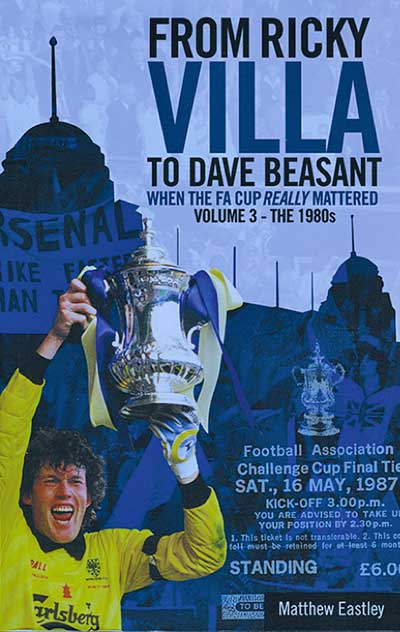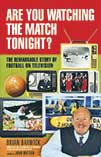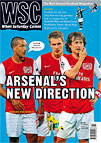Search: 'Barry Davies'
Stories
With John Motson soon to retire, the age of distinctive commentators’ voices has ended. In their place are a group of estate agentesque safe choices
 When the FA Cup really mattered Vol 3
When the FA Cup really mattered Vol 3
by Matthew Eastley
Pitch Publishing, £14.99
Reviewed by Jonathan Paxton
From WSC 342 August 2015
It’s hard to imagine Aston Villa or even Arsenal fans looking back on this year’s FA Cup final with much nostalgia but a dip into Matthew Eastley’s entertaining trip through finals from the 1980s is a pleasant reminder of why the competition’s heritage means so much to fans of a certain age. This was a time when Cup runs excited whole communities and smaller clubs had genuine hopes of reaching Wembley and lifting the famous trophy.
The stories, told chronologically from West Ham’s win over Arsenal in 1980, are recalled by fans in their own words and the absence of journalistic hyperbole is welcome. Interviews with supporters at Wembley on the day gives the stories a down-to-earth quality and fans of all clubs will understand quirks such as the West Ham fan who stuffs his Wembley ticket in his Y-fronts for safe keeping. Referencing hit singles and news stories of the day is a standard, if predictable way of placing the events in time but, by having fans recall the horrendous fashions of the era, we identify closely with them.
The other device used by Eastley is to revisit TV coverage of the day’s build-up and match. Cup final editions of Mastermind and It’s A Knockout are recalled with little affection and one wonders how Michael Barrymore blacking up to greet John Barnes at the Watford team hotel in 1984 was ever considered appropriate. Yes, we’ve all seen Ricky Villa’s goal and Gordon Smith’s miss but Eastley still manages to maintain some tension when describing matches and even the dire 1982 final is injected with drama. Some match reports (particularly from earlier rounds) do get a little stat heavy however and transcripts of John Motson’s commentary and basic descriptions of well-known action don’t add much to our knowledge of the matches. The occasional nugget does appear though: the tragic story of Welsh international winger Alan Davies (a winner in 1983 with Manchester United) is briefly touched upon and feels like it deserves its own book.
While there is no nostalgia for hooliganism, anecdotes of fans sneaking onto the opposing terraces are written with a sense of cheeky fun but descriptions of a dilapidated Wembley and crowd congestion are ominous. For those who fail to get tickets through the official channels, going directly to touts is seen as a perfectly viable option at the time and poor policing and stewarding is the norm. The author deserves great credit for his handling of the 1989 final.
Whether a supporter of the clubs involved or not, most fans will find something to identify with here. Those around at the time will enjoy the evocative memories but for younger fans, brought up on Sky coverage and all-seat stadiums, the sport may be unrecognisable. While it will probably find more warmth in Brighton and Coventry than in Liverpool or Manchester, this is an enjoyable retrospective of a time when Cup finals did actually stay long in the memory.
 The remarkable story of football on television
The remarkable story of football on television
by Brian Barwick
Andre Deutsch, £18.99
Reviewed by Roger Titford
From WSC 321 November 2013
There’s one memorable phrase in this book, describing the television pictures from the 1970 World Cup in Mexico as “blurred, almost like a watercolour painting caught in a rainstorm”. There are also a fair smattering of interesting or half-forgotten facts: only 12 matches were televised live at the 1966 World Cup finals, the term “route one” came from the show Quiz Ball, and there is a reminder that TV folk generally do not produce great works in print. Efforts by John Motson, Jeff Stelling and Barry Davies come to mind.
To give Brian Barwick his due, this is an intentionally lightweight account for the less well-informed and written in a matey journalese liberally splashed with exclamation marks. It is the complete opposite of a misery memoir – everyone has a wonderful time, are great friends and meet famous people. Andy Gray’s Sky career ends with an “alleged misdemeanour” and the ITV Digital fiasco of 2002 is glossed over in a single paragraph. The content is as uncontroversial and pro-establishment as a footballer’s autobiography of the 1950s. Those who would question the structure of the Champions League are dubbed “purists and romantics”. Such an approach is to be expected by a former chief executive of the FA and head of BBC and ITV Sport in a long and successful career which continues as a consultant.
Barwick’s story follows a fairly straightforward chronological path from the first TV pictures in 1936 to the present day and is certainly more colourful on the 20th century era in which he was personally involved. He reminds us of what happened with a mix of social history-lite and obvious landmark matches. But he ignores his unique opportunity to reveal the story of how it was done – how the techniques of football coverage have adapted, or not, to audience demands.
He does make a couple of points about how TV commentary has evolved into a conversation between commentator and pundit and how there now can be too many action replays for his taste, to which he regrettably adds the words “I digress”. Actually, this is potentially more interesting than a repetition of the value to Alex Ferguson of Mark Robins’s Cup-winner at Forest in 1990. And it is certainly more interesting than the semi-macho accounts of scraps between BBC and ITV staff when trying to get inconsequential post-match interviews as players come off the Wembley pitch.
Perhaps there is value in the anecdotes. Roy Kinnear gets mistaken for Joe Kinnear. Jimmy Hill gets to take sex symbol Raquel Welch to Chelsea. George Best nearly doesn’t turn up. After spending the morning at the British Grand Prix, Barwick flies by private plane to the World Cup final in Paris and gets locked in a stadium toilet while relieving himself of the champagne he drank on the way. My heart bleeds. Alas my sides do not ache. Maybe they are the kind of stories where you had to be there rather than just sitting at home watching TV.
 Cameron Carter explores how the concept of a Big Four is no longer enough
Cameron Carter explores how the concept of a Big Four is no longer enough
Consensus is a hard thing to come by. How, for instance, can we begin to arrive at agreement on the true source of the riots around England when the Football Focus team cannot even decide how many teams make up the Big Four? It used to be easier when it was just Manchester United, Chelsea, Arsenal and Liverpool. They were our Tesco, Sainsbury’s, Asda and Morrisons. There was no ambiguity at this time, no indecision. But the Premier League, like the world outside, has become a more complex place.
At the start of Football Focus on August 13 the concept of a “top six” was given its first airing, presumably constructed by BBC imagineers from the previous top four plus Manchester City and Spurs, while later in the same programme Eric Cantona was asked how he thought the “top five might finish”. There was still time before the end for Patrick Vieira to question how Wolves would do this season against the “top four or five”.
This matter had not been cleared up by the following Saturday, when Rafa Benítez considered how Everton would compete with the “top six”. It seems unfair that Everton have to face up to two more top clubs – that is, four more top games – than Wolves this season. One solution, albeit in an already crowded fixture list, is a pre-season mini-league featuring the nominal Big Six, to decide which teams are entitled to be formally named as the Big Four.
Otherwise, the worst case scenario here is that the Big Four expands incrementally, as more overseas investors buy into Premier League Sleeping Giants, until we have a ‘”Big 11″ by the end of the decade. At the point that numbers in the elite pool are greater than those outside it, we should all go down to the sea and wait for the world to be cleansed with fire.
For those of us awaiting the annual glory that is Lineker’s Marvellous Line, there was a credit-crunch, own-brand disappointment this year. Generally, before the theme music of the first Match of the Day of the new season, Gary stands before us in a glossy black shirt and, with dancing eyes, unleashes an adrenalin shot in the form of a carefully sculpted sentence prepared for him by a team of resting novelists.
Barry Davies started the big curtain-raiser soundbite trend with his Rupert Brooke desecration: “Stands the clock at ten-to-three/and is there football still to see?” Since then, twinkly Des Lynam, followed in turn by the lad Lineker, made a point of letting us know that they, like ordinary people everywhere, were simply treading water all summer until a thrilling new football season began.
This time, however, Gary was seated, not standing, and his eyes before he vocalised spoke of a terrible new maturity, learned possibly from accidental exposure to non-sports-based world news on his satellite television. All he said was “It’s been an awfully long summer” before introducing his sidekicks and the games as if it were any old Saturday. The absence of knowingly familiar expectancy-building in this welcome was somehow more disheartening than all the other cuts so far imposed on the UK’s population since the general election. It is surely but a short step from excising unnecessary opening-day vivaciousness in our flagship terrestrial football programme to banning all forms of dance, theatre and social dieting as unpatriotic fripperies.
Dan Walker’s mania for dragging the Football Focus cameras around dressing rooms continues apace. On the opening morning of the season, to demonstrate possession of the Access All Areas wristbands, he swanned into the Brighton dressing room where he was rewarded with the sight of 13 Brighton players seated around the bench studiously reading the match programme. You might think the point of going backstage is to show a fly-on-the-wall slice of life, to give your viewership a rare glimpse of the daily lives of the men they only otherwise get to see on the pitch, on television or, very rarely, in the flesh, flushed with refreshment and demanding that the manager of the country club sets up the karaoke.
But no, Dan stole behind the scenes to discover a carefully stage-managed tableau of young men with heads bowed wonderingly over a difficult text, not dissimilar in composition to Rembrandt’s Anatomy Lesson of Dr Nicolaes Tulp. It was a lovely image, but surely with Robbie Savage in the same room, there would more naturally be towel-flicking and banter containing sexual swear words? A bit of advice, young Walker – if you are going to barge in on somebody, make sure they are unprepared.
From WSC 296 October 2011